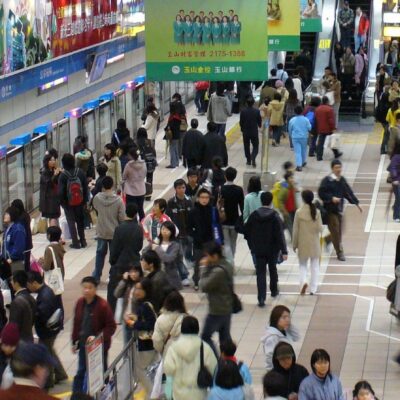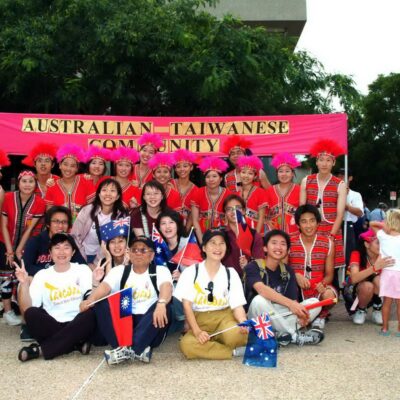When two Kelpie sheepdogs and the first consignment of 2,500 Australian sheep arrived in a remote Korean village of Unbong in the summer of 1972, few would have imagined it would lay the foundations for one of the most successful yet forgotten episodes in Australian aid diplomacy.
Our research on a hitherto unresearched history of Republic of Korea-Australia foreign aid engagement in the 1970s has found that relatively small projects which focus on both the technical issues and country-to-country diplomacy can result in significant and lasting long-term mutual benefits for both the donor and recipient countries.
We have unearthed an unlikely story of Australia’s involvement in the development of rural Korea which marked an important new phase in ROK-Australia relations. It is also a good example of Australia’s past foreign aid efforts which were driven by diplomatic aims rather than immediate need to advance trade, security and strategic interests in the region. However, almost a half century later, these diplomatic efforts laid the foundations to a relationship that is now one of Australia’s most important in trade, regional security and global diplomacy.
Australian Kelpies go to Korea
Emerging from the destruction of the Korean War in the 1950s, the South Korean economy was left in ruins, and one of the main tasks of the post-war Korean administrations was to seek foreign aid which would allow for sustainable re-building of the domestic economy. While much has been made of Korea’s industrialisation and the so-called ‘Miracle of the Han River’ since the 1960s, very few know of the important role that Australia played in the development of Korea’s domestic agricultural sector.
On 11 June 1972, a shipment of 360 sheep and two Australian Kelpie sheepdogs (named Mick and Monty) departed from Sydney Airport on a chartered Qantas 707 freighter on their way to Unbong in Korea. These carefully selected animals were part of the first consignment of 2,500 Australian sheep, farming equipment and machinery, pasture seeds, veterinary vaccination and technical expertise donated by the Australian government to Korea through the Colombo Plan. The Colombo Plan for Cooperative Economic and Social Development in Asia and the Pacific was an intergovernmental organisation established in 1950 to promote social and economic development in the region, and Australia was one of the original aid donor countries. Although education and training have often been seen as Australia’s main contribution to the Colombo Plan, Australia also provided valuable technical assistance to member countries. Australian scientists worked to develop agricultural irrigation systems in Thailand, took part in reforestation efforts in Laos and Nepal, and provided technologies to improve livestock farming and pasture technology in a number of Asian countries.


Images from the Unbong sheep demonstration farm. Image courtesy of Celia and Robert Galland. Reproduced with permission.
While Australia has been part of the Colombo Plan since its launch in 1951, Korea only joined the organisation in 1962 after overcoming some initial opposition from other member countries. Economic development was a priority for Korea at the time of applying. Self-sufficiency (juchae), industrialisation and increased agricultural productivity were the main concerns for Park Chung-hee’s first Five-Year Economic and Social Development Plan in 1962, and the improvement of livestock farming was therefore of great interest to the new administration. In 1962, the Korean government enacted a Five-Year Livestock Promotion Plan which sought to develop unused mountain ranges into grazing land, among other objectives. Later that year, Korea applied for the Colombo Plan to receive 100 Australian Merino sheep to be located in Jeju Island, and to receive short-term training from an Australian expert in all aspects of sheep raising and pasture management. The request from Korea, as insignificant as it may have appeared, could have been seen by Australia as a potential threat to its leadership in the wool industry and wool exports. Instead, the Australian embassy in Korea saw it as ‘extremely worthwhile’ and took a stance of goodwill and respect for Korea’s attempts to build self-sufficient agricultural industry, arguing:
‘ [T]he small sheep industry on Cheju-do [Jeju Island], if properly developed with a little Australian assistance, is capable of providing some additional income to a very poor section of a poor country and additional employment on an island where there is presently a good deal of unemployment or underemployment.”(1)
Fred Morley—then Chief Research Scientist at the Division of Plant Industry at the Commonwealth (Scientific and Industrial Research Organisation CSIRO) and renowned for his improvement of Australian Merino breeding techniques—along with Helen Newton Turner and Robert Bruce Macleay Dun, provided a handwritten yet thorough assessment of the Jeju plan. In the years that followed, the Korean application received a significant boost after a state visit by then President of Korea, Park Chung-hee (1963-1979) to Australia in 1968. In a summit between Park and then Australian Prime Minister John Gorton (1968-1971), Australia committed to exploring the possibility of providing technical assistance for the development of the livestock industry in Korea. Following a feasibility study conducted by an Australian expert in the field, it was decided that a sheep demonstration farm to show Korean farmers ‘what can be done with pasture improvement and selective breeding to increase their productivity and at the same time make significant contribution to National Income.’ (2) Despite the initial Australian suggestion of Jeju island as a possible location, the town of Unbong located at the foot of Mount Jiri in southwestern Korea was ultimately chosen by the Korean authorities to host the first and only Korea-Australia sheep demonstration farm. The site was chosen to minimise the potential threat to livestock health caused by the presence of a mosquito-borne sheep disease endemic to Korea, and aimed to ‘demonstrate Australian methods of sheep raising with the objective of adapting these methods to the Korean climate and agricultural system (3).’ Dual purpose breeds such as Corriedale and Polwarth were chosen for the project in order to provide both meat and wool for the Korean market. While lamb was not a popular meat among Koreans, much of the meat was later sold in Seoul for the consumption of foreign residents living and working in Korea.

Image courtesy of the National Archives of Australia. NAA: A6180, 22/6/72/14. Reproduced with permission.

A consignment of sheep arrive in Korea. Image courtesy of Huon M. Hassall OAM. Reproduced with permission.
During our interviews, Huon Hassall and Bob Galland, the Australian project managers of the Unbong Demonstration Farm between 1971 and 1976, remembered the years in Korea with much pride and joy. A tiny Australian presence in a remote town, along with thousands of sheep and dextrous kelpie sheepdogs at work provoked much curiosity and drew the attention of locals. It took very little time for the Australians to become part of the local community, and their presence was much appreciated by locals who understood that the intent was to improve the lives of the local population who often felt left out of the economic development happening in urban centres. The remoteness of the farm and the small size of Unbong meant that the Australian team would mingle with locals in the markets, attend local festivities, and their children joined Korean children in play. The women who accompanied their partners taught Korean women how to weave wool and knit jumpers, which were then sold to US Army personnel in Korea with a label ‘Made at Unbong’. Local students visited the farm and the Australians visited local schools, teaching English and animal husbandry.

Korean delegates visiting the farm with Huon Hassall on the left. Image courtesy of the Korean National Institute of Animal Science. Reproduced with permission.
Despite many unforeseen difficulties such as having to improvise much of the repairs needed to agricultural equipment used for the project, the Australian team worked to enhance livestock farming in Korea, especially in the area of pasture improvement, and trained Korean managerial and technical personnel in all aspects of sheep husbandry. But the project was essentially a collaboration between the Australians and the Koreans, and both Hassall and Galland recalled the support and determination of the Korean staff who worked tirelessly to make the Unbong project possible. Indeed, the sheep demonstration farm was a source of pride and interest for both Australian and Korean governments, and both lent support to the project. The Australian Ambassador to Korea, Murray Goulburn Madden Bourchier, closely followed the development of the farm and high level Australian officers included Unbong in their official visits to Korea. During one of these visits, Sir Ian Sinclair, then the Deputy Leader of the National Party, gave an impromptu demonstration of his sheep shearing skills much to the astonishment of locals and the Australian staff who were surprised to see a senior Australian politician doing manual labour and muddying his clothes.

(From left to right) A high level visit to the farm in 1973 with Ambassador Murray Bourchier, Bob Galland, Sir Ian Sinclair, and Huon Hassall. Image courtesy of Huon M. Hassall OAM. Reproduced with permission.
The bilateral project lasted for five years, after which the Australian government turned over the full management of Unbong Demonstration Farm to the Korean authorities in December 1976, although the project received further Australian assistance for a little longer. Australian sheep roamed Unbong until the 1990s but the demonstration farm eventually was replaced by the Animal Genetic Resources Station of the Institute of Livestock and Veterinary Science (now National Institute of Animal Science). However, the techniques acquired by the local team and Korean agricultural scientists went on to have a significant impact on the Korean domestic livestock industry. Indeed, the principles of ruminant livestock management, as well as applied research on soil improvement, land resource use, mountain pasture and winter fodder production and disease control that the Australians brought to Korea greatly helped in the modernisation of livestock farming, especially in terms of animal nutrition and health. (4)
The long-term benefits of diplomacy, aid and technology transfer
When the Kelpie sheep dogs Mick and Monty were sent to Korea half a century ago, they were part of Australia’s broader plan to utilise overseas development assistance as a diplomatic tool to build long term friendships with nations who at the time showed very little likelihood of becoming Australia’s major trading partners. At the time, Korea was one such country in need and Australia responded to its call, not for immediate trade or strategic benefits but to promote wider regional growth and security because it was seen as the right thing to do.
While much has been discussed about the effectiveness of overseas development assistance, the Unbong project showed that a long-term, well-planned, and respectful public and diplomatic engagement through development assistance can bring significant benefit to the countries involved; and that these may take a long time to pay off. In the case of Korea, the full benefits of building solid bilateral relations based on mutual trust have only become visible in the past decade. The Australia-Korea bilateral relations reached a new peak late last year with the upgrading of the bilateral relationship to a Comprehensive Strategic Partnership, and new significant investments and strategic collaborations being announced in the area of defence, green energy, gas, lithium and of course – agriculture. While the changes in the Indo-Pacific security landscape have of course played a role in building a greater urgency for Australia and Korea to collaborate more closely in the future, we suggest that the basis for this relationship were forged not only in the shared battlefields during the Korean War, but also partly through little known, but profoundly important collaborative projects such as the Unbong sheep demonstration farm.

A statue in Unbong commemorating the project. Image courtesy of the Korean National Institute of Animal Science. Reproduced with permission.
Despite some criticisms and controversies around the Colombo Plan, the Unbong project brought Australia closer to Korea and in doing so evidenced remarkable foresight in building long term relationships based on trust and reciprocity. At the time, Australia’s approach to developing countries in the region seems to have been one that often went beyond a mere donor-recipient relationship. Through development projects like the Unbong sheep demonstration farm, Australia showed a level of care, concern and trust that became a solid building block of lasting diplomatic relationships, even after the project was largely forgotten. In a way, this important story of sheep and kelpies of Unbong is a timely reminder that a nation’s ability to listen and lend a hand is the reflection of the country’s inner integrity and credibility—a soft power effect that should not be underestimated in the greater play of foreign policy because it lays the foundations of trust and long-term shared future.
1. Colombo Plan – Korea – sheep and wool industry – sheep production development – Cheju Island. NAA: A8520, MK68/12/1.
2. Current Notes on International Affairs , Vol 41, No. 7 (1070), p. 4
3. Letter from RG Spratt to Dr JR Price, 20 August 1971. Colombo Plan – Korea – sheep and wood industry – establishment of a sheep demonstration farm. NAA: A8520, MK68/12/2.
4. Korea Australia Sheep Demonstration Farm and Advisory Centre Project – February 1976. NAA: A8950, 2015.
Authors: Dr Hea-Jin Park, Associate Professor Joanna Elfving-Hwang, Younghye Seo Whitney.
Main image: The two kelpies Mick and Monty with the first consignment of sheep in 1972 Image courtesy of the National Archives of Australia. NAA: A6180, 22/6/72/13. Reproduced with permission.




